| ↑ Swim home | ← Back stroke |
Swimming Hole AccessoriesSwimming Hole Heaven
As a swimming hole fanatic, here are my top ten swimming hole accessories that I use and recommend when swimming in freshwater rivers, lakes and waterfall pools. This equipment has helped
me embark on my swimming hole adventures more safely, with less worry and more enjoyment in the water.
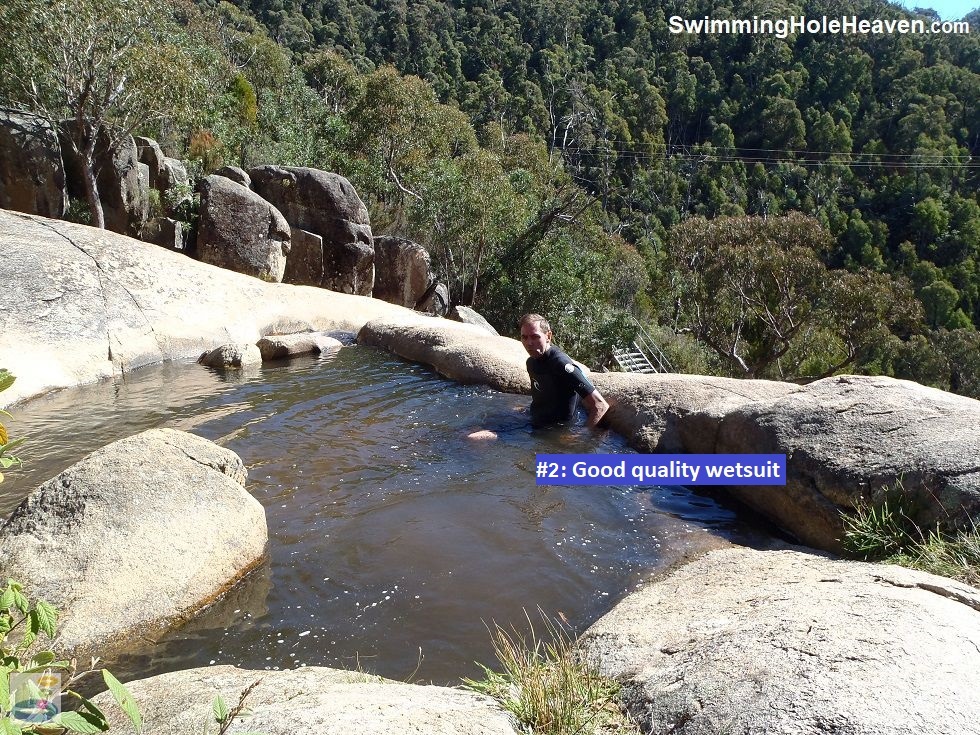 Above: Shivering uncomfortably with joints aching in the icy pool above Gibraltar Falls in the years before I had a full length wetsuit
(Order this image)
Above: Shivering uncomfortably with joints aching in the icy pool above Gibraltar Falls in the years before I had a full length wetsuit
(Order this image)
Disclaimer: If you purchase products via the links in this article, I may receive a commission at no extra cost to you. For more information see my affiliate links policy.
Swimming Accessory #2: A good quality wetsuit
Swimming Accessory #3: Waterproof key pouch and waterproof key
Swimming Accessory #4: Tow float
Swimming Accessory #5: Prescription mask and goggles
Swimming Accessory #6: Training fins
Swimming Accessory #7: Towel kaftan
Swimming Accessory #8: Waterproof camera
Swimming Accessory #9: Plastic tub and coathanger
Swimming Accessory #10: Inflatables
Swimming Accessory #11: Other protective equipment
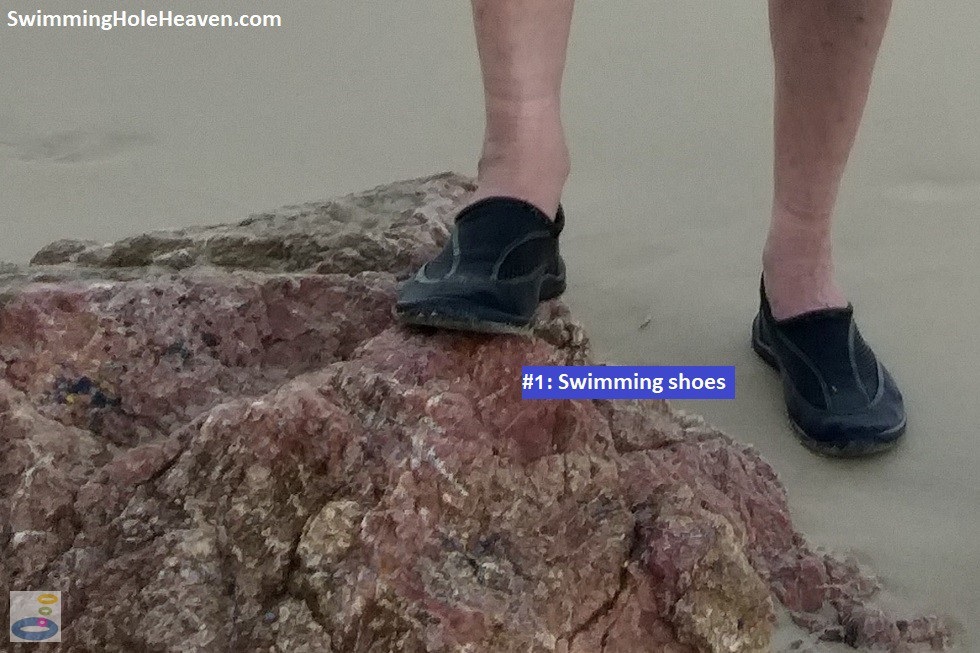 Above: My swimming shoes
(Order this image)
Above: My swimming shoes
(Order this image)
You should be able to walk comfortably both in and out of the water in your swimming shoes, and I often use them for short bushwalks back to my car rather than going to the effort of putting my socks and shoes back on next to the water. Browse and order swimming shoes here.
You can pick these up seasonally from most department or outdoor stores, but they are often removed from shelves over winter. Ideally swimming shoes should be light weight and not restrict your swimming.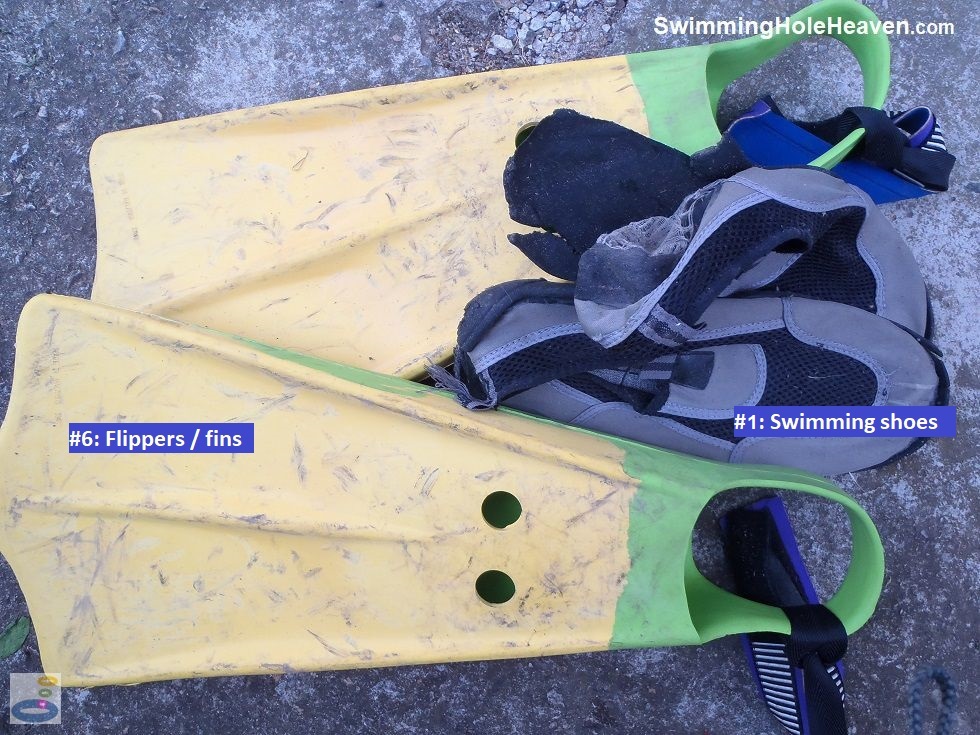 Above: The day my equipment failed at Bend of Islands when my swimming shoes were ripped to shreds on the rocks in the rapids, but better
my shoes than my feet.
(Order this image)
A few years ago I invested in a 3/2 mm full length wetsuit with tapered sleeves and a thermal chest that provides next level warmth. It is the single best big investment
in swimming hole equipment that I have made. I bought mine from Need Essentials,
who operate out of a warehouse in surf mecca Torquay, and it is still performing as new after many swims in the bush over several years.
Above: The day my equipment failed at Bend of Islands when my swimming shoes were ripped to shreds on the rocks in the rapids, but better
my shoes than my feet.
(Order this image)
A few years ago I invested in a 3/2 mm full length wetsuit with tapered sleeves and a thermal chest that provides next level warmth. It is the single best big investment
in swimming hole equipment that I have made. I bought mine from Need Essentials,
who operate out of a warehouse in surf mecca Torquay, and it is still performing as new after many swims in the bush over several years.
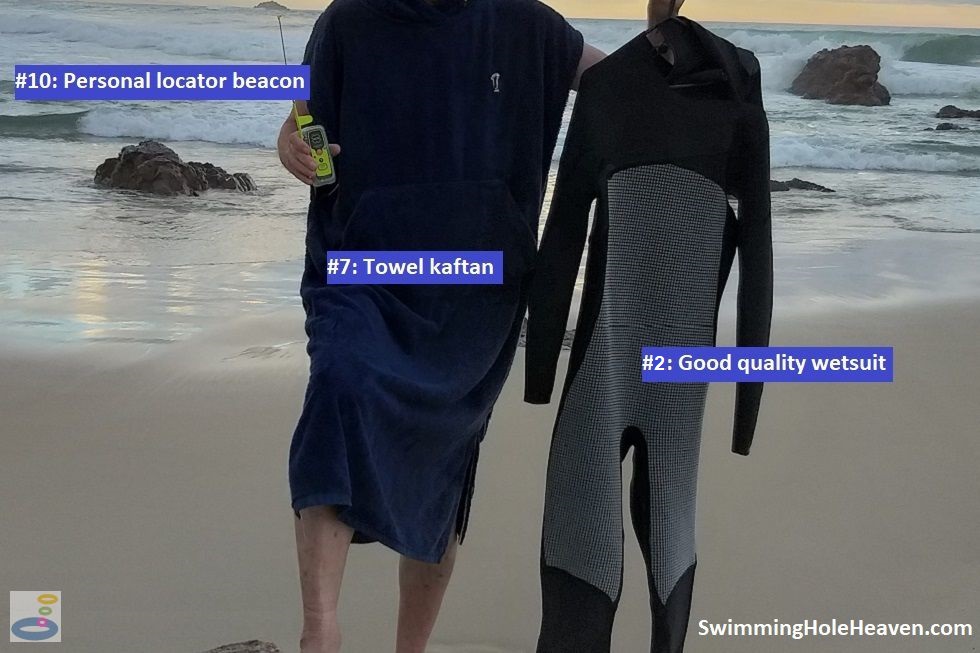 Above: A good wetsuit for the water, a towel kaftan for changing and getting dry, and a personal locator beacon for remote swimming hole emergencies
(Order this image)
Above: A good wetsuit for the water, a towel kaftan for changing and getting dry, and a personal locator beacon for remote swimming hole emergencies
(Order this image)
The key features (regardless of brand) are the tapered sleeves that fit snug around your ankles and wrists, the neck collar that goes over your head (which provides better water sealing around your neck) with only a horizontal chest zipper, and the thermal material on the chest and back. Also make sure it has a loop or an external pocket that you can tie things onto or store things in if you need - I use the loop on my wetsuit to attach my camera cord, for example. I found I can swim unhindered in a 3 mm suit, but thicker wetsuits that I have hired from time to time tended to inhibit my arm movement, so I would only go for a thicker suit if snorkelling rather than swimming.
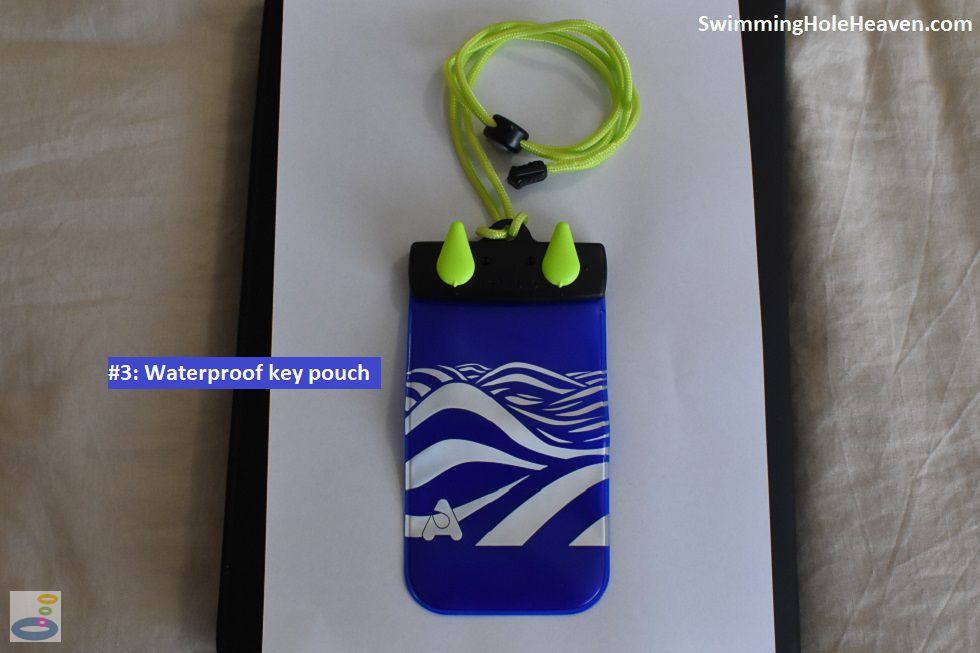 Above: My waterproof key pouch, which sits under your wetsuit, in between your shoulder blades
(Order this image)
Above: My waterproof key pouch, which sits under your wetsuit, in between your shoulder blades
(Order this image)
Whilst I have not experienced it, there is still a very small risk that the pouch may let some moisture in. If your electronic car key gets wet, it won't work. To get around this risk, I had a spare metal key (non-electronic) cut by a locksmith that I can take into the water without worrying whether it will get damp or not. This kind of key allows you to open your car door, but not start the car. You can then hide your electronic key inside the car in a hard to find place or in a lock box that you either leave in the car or leave with your gear. Your car still might get stolen, but at least you have made it challenging for the thieves. Some pouches are also designed to carry your phone, but I am not sure I would trust them enough if my phone was not waterproof.
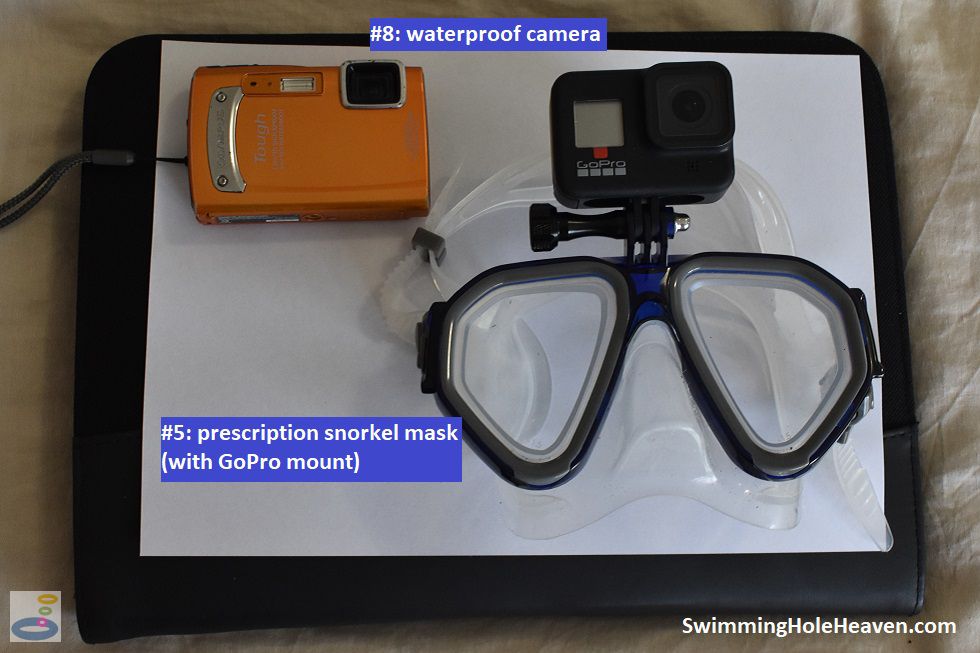 Above: My waterproof cameras and my prescription snorkel mask with GoPro mount for a waterproof camera
(Order this image)
Above: My waterproof cameras and my prescription snorkel mask with GoPro mount for a waterproof camera
(Order this image)
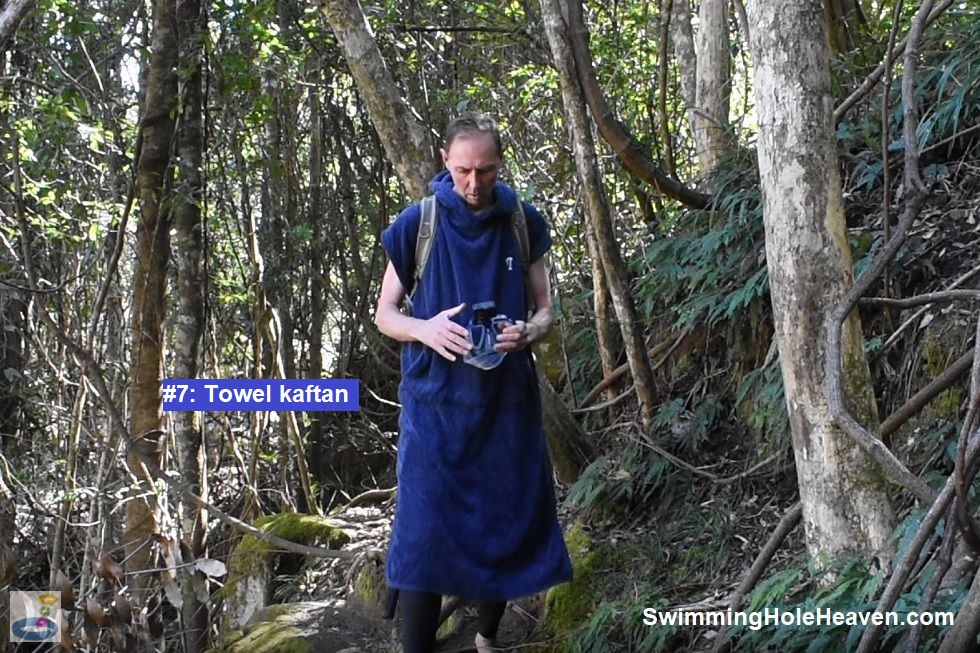 Above: Wearing my towel kaftan on the way to Whian Whian Falls
(Order this image)
Above: Wearing my towel kaftan on the way to Whian Whian Falls
(Order this image)
I received a fairly plush hooded towel as a gift from a relative from Terry Rich, which is thicker and offers a bit more warmth, but if you are after something lighter or cheaper, you can order a towel kaftan here.
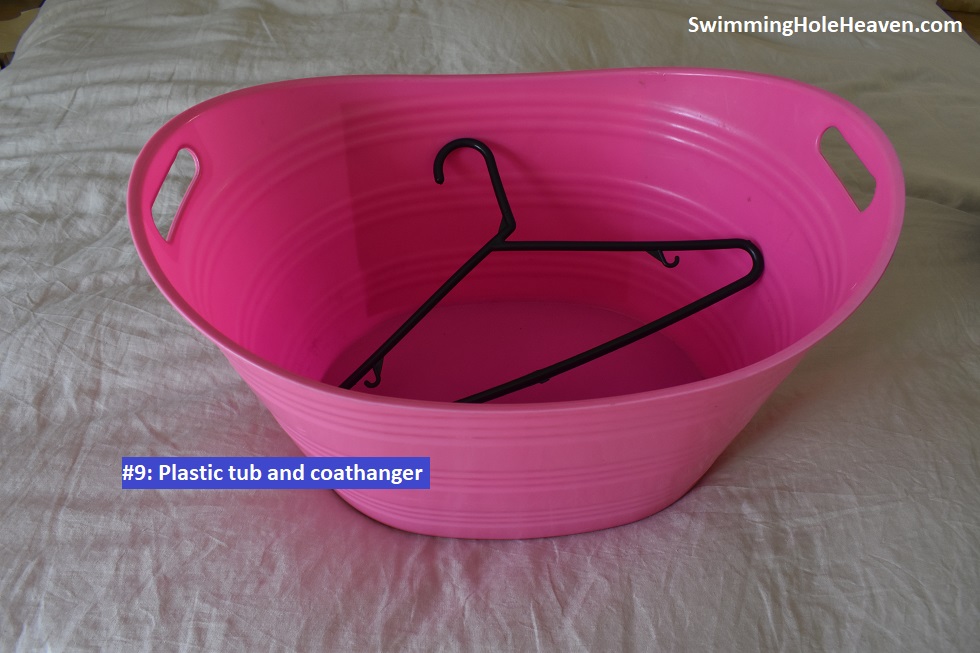 Above: A waterproof plastic tub and coathanger for wet gear
(Order this image)
Above: A waterproof plastic tub and coathanger for wet gear
(Order this image)
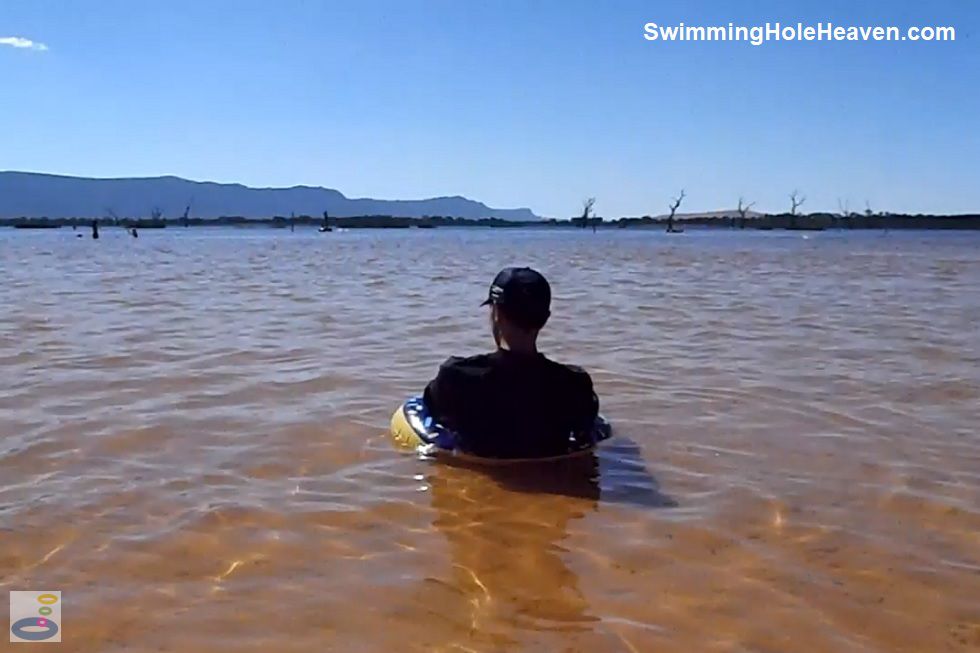 Above: Drifting in my inflatable rubber ring at Lake Fyans
(Order this image)
Above: Drifting in my inflatable rubber ring at Lake Fyans
(Order this image)
I hope that these suggestions will help you to enjoy your outdoor swimming experiences even more than you do now. Also keep them in mind for birthday gifts or Christmas gifts for swimmers. If you use an alternative piece of equipment that you think I should try, drop me a line on my contact form.
Before you head out, make sure to read the swimming safety information.
 Above: Shivering uncomfortably with joints aching in the icy pool above Gibraltar Falls in the years before I had a full length wetsuit
(Order this image)
Above: Shivering uncomfortably with joints aching in the icy pool above Gibraltar Falls in the years before I had a full length wetsuit
(Order this image)
Disclaimer: If you purchase products via the links in this article, I may receive a commission at no extra cost to you. For more information see my affiliate links policy.
Contents:
Swimming Accessory #1: Swimming shoes
Swimming Accessory #2: A good quality wetsuit
Swimming Accessory #3: Waterproof key pouch and waterproof key
Swimming Accessory #4: Tow float
Swimming Accessory #5: Prescription mask and goggles
Swimming Accessory #6: Training fins
Swimming Accessory #7: Towel kaftan
Swimming Accessory #8: Waterproof camera
Swimming Accessory #9: Plastic tub and coathanger
Swimming Accessory #10: Inflatables
Swimming Accessory #11: Other protective equipment
Swimming accessory #1: Swimming shoes
Why do I use swimming shoes? Swimming shoes protect your feet from sharp rocks, broken glass, oyster shells, and anything else sharp or dangerous that you might step on.
I carry these everywhere I swim. Swimming shoes typically have a rubber soul and a mesh or
neoprene upper section that you slip your foot into snuggly like a slipper. Swimming shoes are essential in turbid water when you cannot see obstacles under the water,
or anywhere you think other people might have thrown their empty bottles into the water.
 Above: My swimming shoes
(Order this image)
Above: My swimming shoes
(Order this image)
You should be able to walk comfortably both in and out of the water in your swimming shoes, and I often use them for short bushwalks back to my car rather than going to the effort of putting my socks and shoes back on next to the water. Browse and order swimming shoes here.
You can pick these up seasonally from most department or outdoor stores, but they are often removed from shelves over winter. Ideally swimming shoes should be light weight and not restrict your swimming.
 Above: The day my equipment failed at Bend of Islands when my swimming shoes were ripped to shreds on the rocks in the rapids, but better
my shoes than my feet.
(Order this image)
Above: The day my equipment failed at Bend of Islands when my swimming shoes were ripped to shreds on the rocks in the rapids, but better
my shoes than my feet.
(Order this image)
Swimming accessory #2: A good quality wetsuit
A good wetsuit both keeps your warm and helps you float. Some of my favourite swims in the world like
Ewens Ponds are also extremely cold, even in summer. A decent wetsuit helps to prevent cramp and hypothermia. It enables you to
extend your swimming season into spring and autumn, as well as allowing you to get into the water on cooler days when there is less swimming traffic in the water. I
used a 3 mm Ripcurl spring suit (i.e. short arms and short legs) with a rear zipper for many years,
which worked fine in summer, but did not offer enough warmth in colder water.
 Above: A good wetsuit for the water, a towel kaftan for changing and getting dry, and a personal locator beacon for remote swimming hole emergencies
(Order this image)
Above: A good wetsuit for the water, a towel kaftan for changing and getting dry, and a personal locator beacon for remote swimming hole emergencies
(Order this image)
The key features (regardless of brand) are the tapered sleeves that fit snug around your ankles and wrists, the neck collar that goes over your head (which provides better water sealing around your neck) with only a horizontal chest zipper, and the thermal material on the chest and back. Also make sure it has a loop or an external pocket that you can tie things onto or store things in if you need - I use the loop on my wetsuit to attach my camera cord, for example. I found I can swim unhindered in a 3 mm suit, but thicker wetsuits that I have hired from time to time tended to inhibit my arm movement, so I would only go for a thicker suit if snorkelling rather than swimming.
Swimming accessory #3: Waterproof key pouch and waterproof key
This is not such an issue if at least one person from your swimming group is always with your gear, but if everyone
is in the water, particularly for long distance swimming, it can be difficult to know how to keep your car key safe. There are different approaches available to this problem,
starting with leaving it in your bag or hiding it under your car and hoping no one steals it. I store my key in a waterproof key pouch that you can wear around your neck under
your wesuit. Order a waterproof key pouch here. It sits neatly on your back, between your shoulder blades.
 Above: My waterproof key pouch, which sits under your wetsuit, in between your shoulder blades
(Order this image)
Above: My waterproof key pouch, which sits under your wetsuit, in between your shoulder blades
(Order this image)
Whilst I have not experienced it, there is still a very small risk that the pouch may let some moisture in. If your electronic car key gets wet, it won't work. To get around this risk, I had a spare metal key (non-electronic) cut by a locksmith that I can take into the water without worrying whether it will get damp or not. This kind of key allows you to open your car door, but not start the car. You can then hide your electronic key inside the car in a hard to find place or in a lock box that you either leave in the car or leave with your gear. Your car still might get stolen, but at least you have made it challenging for the thieves. Some pouches are also designed to carry your phone, but I am not sure I would trust them enough if my phone was not waterproof.
Swimming accessory #4: A tow float
I do not use one of these because I rarely do long distance open water swimming, but if you have more gear to store then they can fit in much more than just your key. They
are typically an inflatable waterproof duffle bag that is tethered to your body that floats along behind you as you swim. These can be good for open water swimming, but are not much
use in rivers where they can float away with the current and snag on objects. You can
order a tow float here if you are open water swimming.
Swimming accessory #5: Prescription snorkel mask and goggles
If like me you wear glasses and cannot see clearly as soon as you leave them on the shore, order yourself a prescription
snorkel mask or a prescription pair of goggles. These are great for seeing under the water while snorkelling, and for checking your position in the moving water
relative to objects on the shore. I was surprised at how cheap these are compared to the cost of my normal glasses and lenses. If you do not know your eye correction, ask
your optometrist for your script which you can use to order your prescription mask or goggles online here.
The prescription goggles are also handy at the local pool if you cannot read the clock or timer on the wall without your glasses.
 Above: My waterproof cameras and my prescription snorkel mask with GoPro mount for a waterproof camera
(Order this image)
Above: My waterproof cameras and my prescription snorkel mask with GoPro mount for a waterproof camera
(Order this image)
Swimming accessory #6: Training fins
Flippers or fins provide extra control in the water when in strong currents such as rivers and tidal estuaries. There are some features you need to look out for when
considering them for wild swimming. Firstly, I recommend the shorter, so-called training fins rather than full-length flippers. Although less powerful, training fins
are much easier to walk with in shallow water than full-length flippers, which I find an advantage when you have to cross shallow riffles to reach a deeper swimming hole.
Secondly, look for a pair that have a rubber loop that runs around behind your archilles tendon, rather than a heel piece. If you are snorkelling or swimming in calm water,
it makes no difference, but having a rubber loop means that you can attach the fins securely to your leg using a velcro strap in the event that they slip off your foot. I
use fins in very strong currents so I can safely power away from rocks or to slip out of the main current.
Order your training fins here.
Swimming accessory #7: Towel kaftan
They look a bit weird but they have one huge advantage in that they allow you to change your wet gear without exposing yourself in a
public place. An excellent option if swimming in public places without access to change rooms, or simply to give your body and your bathers time to dry out before getting changed. It also
means you do not have to carry a towel to your swimming hole, because you are wearing it.
 Above: Wearing my towel kaftan on the way to Whian Whian Falls
(Order this image)
Above: Wearing my towel kaftan on the way to Whian Whian Falls
(Order this image)
I received a fairly plush hooded towel as a gift from a relative from Terry Rich, which is thicker and offers a bit more warmth, but if you are after something lighter or cheaper, you can order a towel kaftan here.
Swimming accessory #8: Waterproof camera
Some phones are waterproof nowadays and take high quality
photos, but without a waterproof phone, I use a separate waterproof camera. I have been using a camera from the
Olympus Tough range for several years
and found it takes high quality images above and below the water. You will need a soft pouch to store it in when not in the water (I cannot remember whether the pouch I
have came with the camera or not) because it does not have a lens cover. I have banged this phone around quite a bit both in and out of the water and it has proven to be
quite robust. The only issues I have with it are that sometimes droplets of water can cover the lens when in the water but not under the water. I also have a
GoPro Hero8 which I
attach to my snorkel mask. I find it hard to take good video when the mask is attached to my head (i.e. it is a good idea for diving, but not so great for snorkeling along the surface).
It does however make it much easier to carry the camera hands free in the water, and gives you something bigger and more stable than the little camera to hold onto when taking video in the water. A
decent waterproof camera can be a big investment, so you will want to do thorough research, but here are some options to buy a waterproof camera.
Swimming accessory #9: A large plastic tub and a plastic coathanger
The tub is used for storing your wet gear in your car after your swim, without getting your car or other gear wet.
Leave the plastic coathanger in your car to hang your wetsuit on the nearest tree, allowing it to drip dry (at least partially), after your swim.
If you are really keen, you can also carry one with you to your swimming spot. Order a plastic tub here.
 Above: A waterproof plastic tub and coathanger for wet gear
(Order this image)
Above: A waterproof plastic tub and coathanger for wet gear
(Order this image)
Swimming accessory #10: Inflatables
Inflatables can add to the fun of your swim, or allow you to extend your time in the water. Inflatables are best suited to deep swimming holes, where there is limited
space on the shore and you cannot touch the bottom away from the shore. I have tried a few different inflatables over the years, such as the inflatable seal at
Expedition Pass Reservoir that was a lot of fun but difficult to balance on. I keep coming back to the trusty inflatable ring, known
in our family as the doughnut, which is the best option for lazy rivers like at Corunna Point. Stay away from the over-sized inflatables
like the giant swan with an inflatable platform for several people - they might look fun but they are hard to control and take up too much space in smaller swimming
holes when sharing the space with others. You can browse and buy an inflatable ring here.
 Above: Drifting in my inflatable rubber ring at Lake Fyans
(Order this image)
Above: Drifting in my inflatable rubber ring at Lake Fyans
(Order this image)
Swimming accessory #11: Other protective equipment
Other protective equipment includes a first aid kit including a
compression bandage for snake bites,
water-resistant insect repellent,
water-resistant sunscreen, etc.
I also have a personal locator beacon when heading to remote swimming holes in the Australian bush, where you can be outside of mobile phone coverage but still be able to send an alert to emergency services if you
get into real trouble and need urgent help. These are often used for boating, so they are usually waterproof. Order a personal locator beacon here,
making sure when you purchase it that it is suitable for your jurisdiction.
I hope that these suggestions will help you to enjoy your outdoor swimming experiences even more than you do now. Also keep them in mind for birthday gifts or Christmas gifts for swimmers. If you use an alternative piece of equipment that you think I should try, drop me a line on my contact form.
Before you head out, make sure to read the swimming safety information.
| ↑ Swim home | ← Back stroke |
| World | Australia |
| Water Safety | Map |
| Links | Your Support |
| List of Lists | Suggest a Swim |
| Community, Media, Research | |
|
|
|
|
|
|
|
|
|
|
© Brad Neal 2024. All rights reserved. Swimming Hole Heaven is a registered trademark. Here are my
affiliate links and cookies policy and opportunities to provide support to Swimming Hole Heaven.